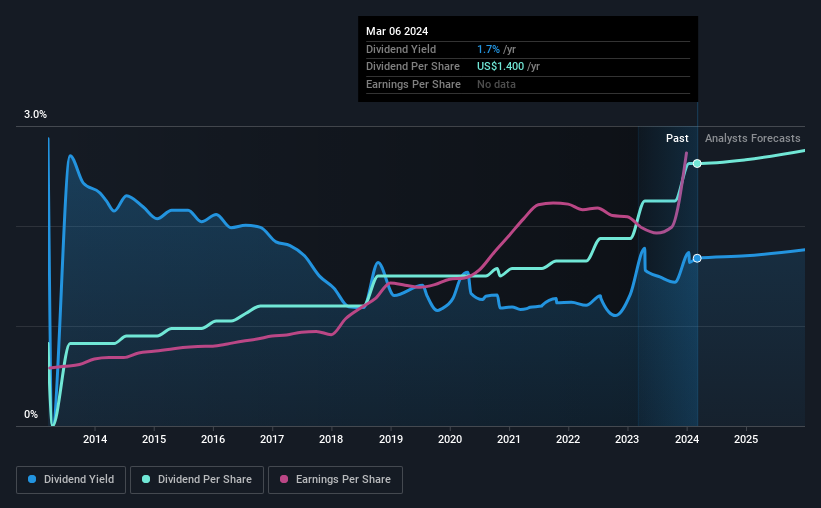Bank First's (NASDAQ:BFC) Dividend Will Be Increased To $0.35
Bank First Corporation (NASDAQ:BFC) has announced that it will be increasing its dividend from last year's comparable payment on the 10th of April to $0.35. Although the dividend is now higher, the yield is only 1.7%, which is below the industry average.
Check out our latest analysis for Bank First
Bank First's Payment Expected To Have Solid Earnings Coverage
It would be nice for the yield to be higher, but we should also check if higher levels of dividend payment would be sustainable.
Bank First has established itself as a dividend paying company with over 10 years history of distributing earnings to shareholders. While past records don't necessarily translate into future results, the company's payout ratio of 16% also shows that Bank First is able to comfortably pay dividends.
Over the next 3 years, EPS is forecast to fall by 26.3%. Despite that, analysts estimate the future payout ratio could be 24% over the same time period, which is in a pretty comfortable range.
Dividend Volatility
The company has a long dividend track record, but it doesn't look great with cuts in the past. The dividend has gone from an annual total of $0.44 in 2014 to the most recent total annual payment of $1.40. This implies that the company grew its distributions at a yearly rate of about 12% over that duration. Despite the rapid growth in the dividend over the past number of years, we have seen the payments go down the past as well, so that makes us cautious.
The Dividend Looks Likely To Grow
With a relatively unstable dividend, it's even more important to evaluate if earnings per share is growing, which could point to a growing dividend in the future. We are encouraged to see that Bank First has grown earnings per share at 14% per year over the past five years. Bank First definitely has the potential to grow its dividend in the future with earnings on an uptrend and a low payout ratio.
We should note that Bank First has issued stock equal to 12% of shares outstanding. Trying to grow the dividend when issuing new shares reminds us of the ancient Greek tale of Sisyphus - perpetually pushing a boulder uphill. Companies that consistently issue new shares are often suboptimal from a dividend perspective.
We Really Like Bank First's Dividend
Overall, a dividend increase is always good, and we think that Bank First is a strong income stock thanks to its track record and growing earnings. The distributions are easily covered by earnings, and there is plenty of cash being generated as well. If earnings do fall over the next 12 months, the dividend could be buffeted a little bit, but we don't think it should cause too much of a problem in the long term. Taking this all into consideration, this looks like it could be a good dividend opportunity.
Companies possessing a stable dividend policy will likely enjoy greater investor interest than those suffering from a more inconsistent approach. Still, investors need to consider a host of other factors, apart from dividend payments, when analysing a company. To that end, Bank First has 3 warning signs (and 1 which is a bit unpleasant) we think you should know about. If you are a dividend investor, you might also want to look at our curated list of high yield dividend stocks.
Have feedback on this article? Concerned about the content? Get in touch with us directly. Alternatively, email editorial-team (at) simplywallst.com.
This article by Simply Wall St is general in nature. We provide commentary based on historical data and analyst forecasts only using an unbiased methodology and our articles are not intended to be financial advice. It does not constitute a recommendation to buy or sell any stock, and does not take account of your objectives, or your financial situation. We aim to bring you long-term focused analysis driven by fundamental data. Note that our analysis may not factor in the latest price-sensitive company announcements or qualitative material. Simply Wall St has no position in any stocks mentioned.

 Yahoo Finance
Yahoo Finance 
